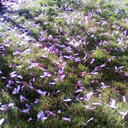Evaluation of the anti-myocardial ischemia effect of individual and combined extracts of Panax notoginseng and Carthamus tinctorius in rats.
Từ khóa
trừu tượng
BACKGROUND
The decoction of combined Panax notoginseng (Burk) F.H. Chen and Carthamus tinctorius L. has a history of use in traditional medicine for the prevention and treatment of cardiovascular diseases such as angina pectoris and myocardial infarction.
OBJECTIVE
In this study, we investigated the effects of individual herbal extracts and combined extracts on anti-myocardial ischemia injuries in vivo, and determined the proper dosage of Panax notoginseng (EPN) combined with Carthamus tinctorius (ECT) that could strengthen their cardio-protective effects. Meanwhile, their potential anti-oxidative stress and anti-inflammation effect were assessed.
METHODS
SD rats were orally given individual EPN 50, 100mg/kg, ECT 100, 200mg/kg, and different combinations between them. Myocardial infarction was produced by occlusion of the left anterior descending coronary artery for 24h. Infarct area was determined with 2,3,5-triphenyltetrazolium chloride (TTC) staining. The biomarkers related to myocardial ischemia injury were determined. Simultaneously, hemodynamic parameters were monitored as left ventricular systolic pressure (LVSP), LV end-diastolic pressure (LVEDP) and maximal rate of increase and decrease of left ventricular pressure (dP/dt(max)). The oxidative stress indicators and inflammatory factors were also evaluated.
RESULTS
The results showed EPN or ECT significantly reduced infarct size, improved cardiac function, decreased levels of creatine kinase (CK) and lactate dehydrogenase (LDH) (all P<0.05 vs. control ). EPN or ECT alone also restrained the oxidative stress related to myocardial ischemia injury as evidenced by decreased malondialdehyde (MDA) and elevated superoxide dismutase (SOD) activity (all P<0.05 vs. control). However, this cardio-protective effect was further strengthened by their combinations. Among all the combinations, EPN 50mg/kg plus ECT 200mg/kg showed predominant potential to reduce infarct size (22.21±1.72%, P<0.05 vs. each single, respectively), preserve cardiac function (P<0.05 vs. ECT 200mg/kg for LVEDP and -dP/dt(max)) after myocardial ischemia injury in rats. This heart protection was confirmed with the lowered cardiac troponin I (cTnI) (P<0.05 vs. ECT 200mg/kg and EPN 50mg/kg, respectively). Oxidative stress and inflammation are the two key factors in the pathogenesis of myocardial ischemia injury. In the present study, EPN 50mg/kg plus ECT 200mg/kg markedly increased SOD and GSH-Px activity (475.30±23.60U/ml, P<0.05 vs. each single, respectively), while elevated MDA level was significantly depressed. Meanwhile, the inflammatory cascade was inhibited as evidenced by decreased cytokines such as tumor necrosis factor-α (TNF-α), C-reactive protein (CRP) and interleukin-1β (IL-1β).
CONCLUSIONS
These results demonstrated EPN, ECT and their combinations exhibited significant cardio-protective effects. The findings suggest EPN combined with ECT may be therapeutically more useful for ameliorating anti-myocardial ischemia injuries than individual herbal extract, and EPN 50mg/kg plus ECT 200mg/kg is the appropriate combination in the present research. The cardio-protective effect of this combination was achieved partially by decreasing oxidative stress and repressing inflammatory cascade.



